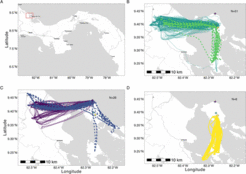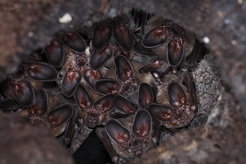Ephemeral resources and social information sharing

Here we investigate bats that seasonally, occasionally or always feed on ephemeral resources, i.e. resources that are unpredictable in time and/or space, and how this can lead to increased foraging efficiency through social foraging and information transfer, ultimately helping to explain sociality in these species.
In the temperate zones, most bats are only seasonally social and the leading hypothesis is that while the costs of sociality outweigh the benefits throughout most of the year, reproductive females benefit from social thermoregulation during this energy-demanding period. However, in the tropics this reason should not apply. Social foraging via acoustic information transfer has been postulated as a putative reason for these seasonal groups. Based on our past work, we have developed a framework to predict if and when social information sharing should occur. Most of our current work on this topic is with species in the Neotropics. For example, bats that are morphologically adapted to open-aerial foraging and a diet of swarming insects, especially Pallas’ free-tailed bat (Molossus molossus). How these bats, which live in small female groups, and leave the roost for an hour or less per day coordinate flight to eavesdrop on each other and find enough food in this short time window and the downstream effects of this on their social behavior physiology and energetics is one examples we study, In collaboration with our former lab member Jenna Kohles we study similar questions in bulldog bats (Noctilio albiventris and leporinus, see also Jenna Kohles). We also look at how social foraging in the omnivorous greater spear-nosed bat (Phyllostomus hastatus, see also Camila Calderon), fig eating bats or European populations of the Egyptian fruit bat, Rousettus aegyptiacus are influenced by local food landscapes.

We use various methods, such as recently developed and miniaturized heart rate transmitters or automatic observation of roosts with pittag readers in addition to various movement tracking technologies to estimate the metabolic costs and benefits of these bats evolved to survive at energetic extremes. Another core focus is the detailed assessment of food distribution in time and space. For the past 25 years, Dina has worked in Panama, often collaborating with Rachel Page and her lab at the Smithsonian Tropical Research Institute where Dechmann is an associate staff member. As a product of this long-term work Dina and Rachel with others have recently published a beautiful coffee table book about the wonderful bats of Panama, illustrated by the photos of Christian Ziegler.



